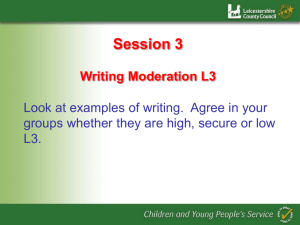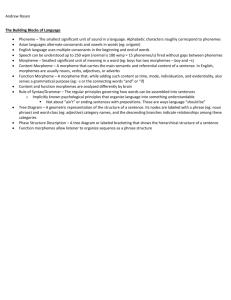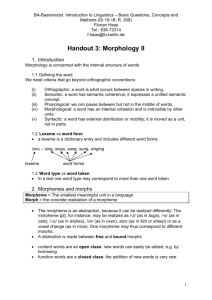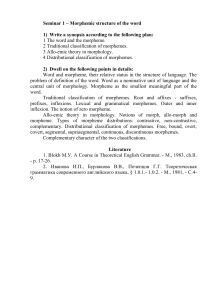Morphology Lecture Notes: Morphemes, Allomorphs, Distribution
advertisement
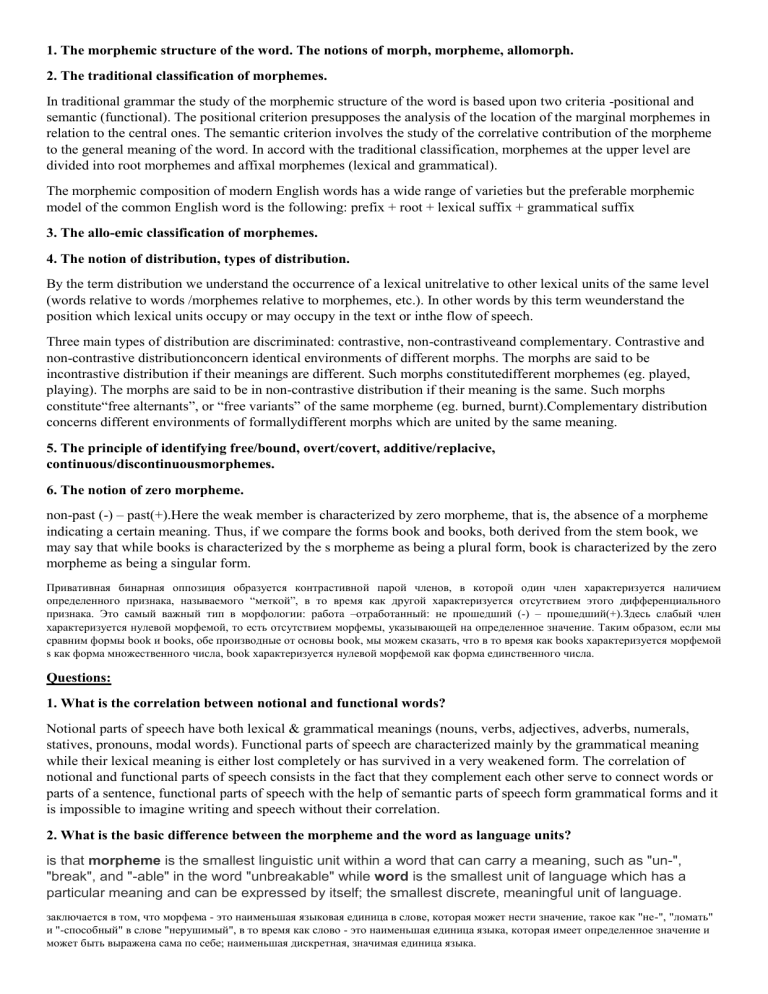
1. The morphemic structure of the word. The notions of morph, morpheme, allomorph. 2. The traditional classification of morphemes. In traditional grammar the study of the morphemic structure of the word is based upon two criteria -positional and semantic (functional). The positional criterion presupposes the analysis of the location of the marginal morphemes in relation to the central ones. The semantic criterion involves the study of the correlative contribution of the morpheme to the general meaning of the word. In accord with the traditional classification, morphemes at the upper level are divided into root morphemes and affixal morphemes (lexical and grammatical). The morphemic composition of modern English words has a wide range of varieties but the preferable morphemic model of the common English word is the following: prefix + root + lexical suffix + grammatical suffix 3. The allo-emic classification of morphemes. 4. The notion of distribution, types of distribution. By the term distribution we understand the occurrence of a lexical unitrelative to other lexical units of the same level (words relative to words /morphemes relative to morphemes, etc.). In other words by this term weunderstand the position which lexical units occupy or may occupy in the text or inthe flow of speech. Three main types of distribution are discriminated: contrastive, non-contrastiveand complementary. Contrastive and non-contrastive distributionconcern identical environments of different morphs. The morphs are said to be incontrastive distribution if their meanings are different. Such morphs constitutedifferent morphemes (eg. played, playing). The morphs are said to be in non-contrastive distribution if their meaning is the same. Such morphs constitute“free alternants”, or “free variants” of the same morpheme (eg. burned, burnt).Complementary distribution concerns different environments of formallydifferent morphs which are united by the same meaning. 5. The principle of identifying free/bound, overt/covert, additive/replacive, continuous/discontinuousmorphemes. 6. The notion of zero morpheme. non-past (-) – past(+).Here the weak member is characterized by zero morpheme, that is, the absence of a morpheme indicating a certain meaning. Thus, if we compare the forms book and books, both derived from the stem book, we may say that while books is characterized by the s morpheme as being a plural form, book is characterized by the zero morpheme as being a singular form. Привативная бинарная оппозиция образуется контрастивной парой членов, в которой один член характеризуется наличием определенного признака, называемого “меткой”, в то время как другой характеризуется отсутствием этого дифференциального признака. Это самый важный тип в морфологии: работа –отработанный: не прошедший (-) – прошедший(+).Здесь слабый член характеризуется нулевой морфемой, то есть отсутствием морфемы, указывающей на определенное значение. Таким образом, если мы сравним формы book и books, обе производные от основы book, мы можем сказать, что в то время как books характеризуется морфемой s как форма множественного числа, book характеризуется нулевой морфемой как форма единственного числа. Questions: 1. What is the correlation between notional and functional words? Notional parts of speech have both lexical & grammatical meanings (nouns, verbs, adjectives, adverbs, numerals, statives, pronouns, modal words). Functional parts of speech are characterized mainly by the grammatical meaning while their lexical meaning is either lost completely or has survived in a very weakened form. The correlation of notional and functional parts of speech consists in the fact that they complement each other serve to connect words or parts of a sentence, functional parts of speech with the help of semantic parts of speech form grammatical forms and it is impossible to imagine writing and speech without their correlation. 2. What is the basic difference between the morpheme and the word as language units? is that morpheme is the smallest linguistic unit within a word that can carry a meaning, such as "un-", "break", and "-able" in the word "unbreakable" while word is the smallest unit of language which has a particular meaning and can be expressed by itself; the smallest discrete, meaningful unit of language. заключается в том, что морфема - это наименьшая языковая единица в слове, которая может нести значение, такое как "не-", "ломать" и "-способный" в слове "нерушимый", в то время как слово - это наименьшая единица языка, которая имеет определенное значение и может быть выражена сама по себе; наименьшая дискретная, значимая единица языка. 3. What is a morph? In linguistics, a morph is a word segment that represents one morpheme (the smallest unit of language that has meaning) in sound or writing. For example, the word infamous is made up of three morphs—in-, fam(e), -eous—each of which represents one morpheme. 4. What does the difference between a morpheme and an allomorph consist in? 5. What principles underlie the traditional study of the morphemic composition of the word? 6. What principles is the distributional analysis of morphemes based on? 7. What are the determining features of the three types of distribution?

